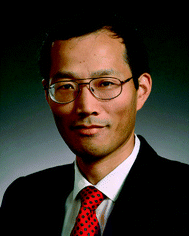Lab on a chip and circulating tumor cells
Z. Hugh
Fan
a and
David J.
Beebe
b
aDepartment of Mechanical and Aerospace Engineering, University of Florida, PO Box 116250, Gainesville, FL 32611-6250, USA. E-mail: hfan@ufl.edu
bDepartment of Biomedical Engineering, Wisconsin Institutes for Medical Research, 1111 Highland Ave, Madison, WI 53705-2275, USA. E-mail: djbeebe@wisc.edu
More than 90% of cancer deaths result from metastasis.1 As a result, improved understanding of metastasis and identifying key regulators could have important therapeutic implications. During metastasis, some cancer cells escape from the primary tumor, enter the bloodstream and become circulating tumor cells (CTCs) in peripheral blood.2 Some of these CTCs acquire the capability to extravasate and colonize secondary sites, spreading tumors to distant organs. Therefore, CTCs can serve as potential biomarkers for cancer diagnostics, prognostics, and theranostics; and improved methods to capture and analyze CTCs could play a pivotal role in deciphering cancer metastasis. However, CTCs in peripheral blood are rare, typically a few CTCs in billions of normal blood cells, making their isolation and enumeration a technical challenge.
Lab-on-a-chip is a unique platform to address this challenge because of its fundamental attributes. The micro scale provides the possibility to increase the interaction opportunities between CTCs and capture agents, which can result in higher capture efficiency. Other attributes include (1) higher surface-to-volume ratio in a microchannel than in a macro-scale tube, and (2) an ability to integrate with other components such as micropillars and mixers, both of which can enhance capture efficiency.3 In some cases, CTC isolation using microfluidic devices has demonstrated superior performance as compared to the FDA-approved CellSearch® system.4–7
In this CTC-themed issue of Lab on a Chip, reviews and research articles have been collected. The topics range from platform development to clinical applications. Two reviews are written by clinicians who summarize current methods for the enrichment and detection of CTCs, discuss the key challenges and perspectives in the context of improved clinical management of cancer patients, and point out opportunities in incorporating clinical needs and regulatory benchmarks into technology development for FDA approval and clinical translation . Three other reviews focus on miniaturized nuclear magnetic resonance, label-free separation methods based on the biophysical and biomechanical properties of CTCs, and microfluidics-based enrichment methods. In the research articles, technologies reported include spiral microchannels with vortices, high aspect-ratio microstructures, magnetic sifters, microcavities, virtual filters between fluids, and other microfeatures. Devices were made from polydimethylsiloxane (PDMS), glass, and thermoplastics. Various types of tumor cells were isolated from clinical samples of breast, lung, gastric, and pancreatic cancer. Moreover, mutational analysis, therapeutic intervention, and pharmacodynamic analysis of CTCs were also explored.
While the technology advances are impressive, translational research, clinical trials and commercial applications must follow to move the technologies into clinical practice where they can improve patient treatment and outcomes. We look forward to continued progress towards clinical impact in the coming years.
Finally, we would like to thank all contributors for their efforts in making this CTC-themed issue a success.
References
- C. L. Chaffer and R. A. Weinberg, Science, 2011, 331, 1559–1564 CrossRef CAS PubMed.
- M. Cristofanilli, G. T. Budd, M. J. Ellis, A. Stopeck, J. Matera, M. C. Miller, J. M. Reuben, G. V. Doyle, W. J. Allard, L. W. Terstappen and D. F. Hayes, N. Engl. J. Med., 2004, 351, 781–791 CrossRef CAS PubMed.
- Z. H. Fan and W. Tan, Nanomedicine, 2013, 8, 1731–1733 CrossRef CAS PubMed.
- S. Nagrath, L. V. Sequist, S. Maheswaran, D. W. Bell, D. Irimia, L. Ulkus, M. R. Smith, E. L. Kwak, S. Digumarthy, A. Muzikansky, P. Ryan, U. J. Balis, R. G. Tompkins, D. A. Haber and M. Toner, Nature, 2007, 450, 1235–1239 CrossRef CAS PubMed.
- S. Wang, K. Liu, J. Liu, Z. T. Yu, X. Xu, L. Zhao, T. Lee, E. K. Lee, J. Reiss, Y. K. Lee, L. W. Chung, J. Huang, M. Rettig, D. Seligson, K. N. Duraiswamy, C. K. Shen and H. R. Tseng, Angew. Chem., Int. Ed., 2011, 50, 3084–3088 CrossRef CAS PubMed.
- P. G. Schiro, M. Zhao, J. S. Kuo, K. M. Koehler, D. E. Sabath and D. T. Chiu, Angew. Chem., Int. Ed., 2012, 51, 4618–4622 CrossRef CAS PubMed.
- W. Sheng, T. Chen, R. Kamath, X. Xiong, W. Tan and Z. H. Fan, Anal. Chem., 2012, 84, 4199–4206 CrossRef CAS PubMed.
| This journal is © The Royal Society of Chemistry 2014 |


